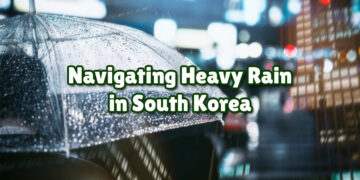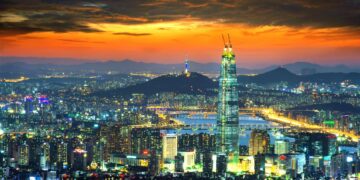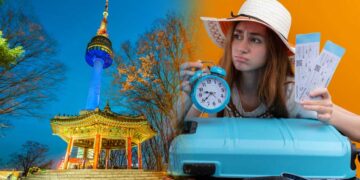Last Updated on 8 months by admin
Don’t let allergies stop you! This guide provides everything you need to know to manage spring pollen allergies while traveling in Korea, empowering you to have a great trip.
Spring is one of the most gorgeous seasons in South Korea. There are a variety of blooming flowers all across the country after the temperatures have warmed up post chilly winters. However, this beautiful season also brings seasonal spring pollen allergies in Korea. Understanding the different types of souces of allergens can help you better deal with it without spoiling your whole trip.
While you may think that flowers are the main source of the pollen spring allergies in Korea, but that isn’t the case!
How Do Pollen Allergies Happen?
You get pollen allergies when you inhale airborne pollen. It triggers an overreaction in the immune system resulting cold like symptoms. Most people assume that they are viral infections. However, colds usually go away on their own in a few days, but pollen allergies can stick around as long as you’re exposed to pollen. So, it’s important to get a proper diagnosis and take care of your allergies. Pollen allergies can cause a range of symptoms, including itchy, runny, or stuffy noses, red, itchy skin, and in severe cases, asthma attacks.
Types of Spring Pollen Allergies in Korea
During spring season, few different types of potential allergens pop up which include tree pollen, fine dust, yellow dust, mold spores, grass pollen, to name a few.
Fine Dust
Fine dust or particulate matter can be really bad for people with allergies. These tiny particles of air pollution are so small, smaller than a human hair, that they can sneak into your lungs and cause irritation and inflammation. If you live or stay in or near cities or factories in Korea, you may be especially at risk. These areas tend to have more pollution, which means more fine dust. The spring season in Korea is usually windy, which means the fine dust particles can float around more easily. So, if you have allergies, like hay fever, exposure to fine dust can make them worse, or even cause new ones.
Yellow Dust
Yellow dust, or Hwang Sa as it is commonly refered to in Korea, is a type of fine dust that comes from China and Mongolia. The winds from these regions carry these tiny harmful particles to Korea. Yellow dust in Korea can be quite strong, and it’s most common in the western and central parts of the country, especially during spring. It can cause breathing issues and make allergies worse. Breathing in yellow dust can also damage the lining of your nose, making allergies and asthma worse.
Grass Pollen
Grass pollen is another common allergen that pops up in Korea during spring. The most common culprits are Timothy grass, Bermuda grass, and ryegrass. If your immune system isn’t used to these grasses, you might be more prone to allergic reactions.
Tree Pollen
In Korea, during spring, trees release pollen into the air, which can cause allergies for some. A study found that the peak months for tree pollen in Korea are March to June. The study also found that during that time, the most common tree allergens are alder, oak, cedar, or elm. Interestingly, the amount of allergen by tree type changed a lot from place to place across South Korea. Cedar, birch, and oak are the most common allegen causing tree pollens in Spring in Korea.
The impact of spring pollen allergies because of trees isn’t the same across Korea. It varies among different regions and depends on individual susceptibility.
How To Manage Spring Pollen Allergies in Korea?
While it may not be possible to avoid them completely, you can take certain precautions to manage them better and keep your travel plans unaffected.
Check AQI Before Making Plans
Environmental management and monitoring daily habits are also crucial for preventing pollen allergies.
Before planning an outdoor adventure, always check the air quality. High pollen and dust days can make allergy symptoms worse. Download apps like IQAir AirVisual or check websites like Seoul Air Pollution: Real-time Air Quality Index (AQI) to stay updated on dust and pollen levels in your area. These apps show you the real-time Air Quality Index (AQI). Good AQI is between 0-50, moderate AQI is between 50-100, and anything above 100 is unhealthy and can affect allergy-sensitive folks. Taking precautions and being aware of the air quality can help you manage your allergies and enjoy nice days outdoors.
If the AQI is higher and on bad air days, you can plan indoor activities. Here are some of the fun things you can do:
- Chill at a nearby cafe
- Watch a movie at local cinema
- Visit an indoor theme park
- Sind your heart out at noraebang
- Shopping in a mall or indoor shopping complex
Wear Appropriate Masks
Masks are super useful for more than just stopping the spread of COVID. They can help you manage respiratory issues, protect yourself from colds and bad weather, and even add a touch of style. Plus, they’re great for keeping dust and pollen out of your lungs, especially on those days when the air quality isn’t great. So, if you’re going outside on a day with poor air quality, don’t forget to wear a mask – it’s a smart move!
When you’re outside, remember to wear a KF80 or higher mask and glasses. This will help keep pollen out of your nose and eyes. Once you’re back home, don’t forget to wash your face and hands, and then change into fresh clothes.
Related Posts
1,864 total views, 1 views today

















